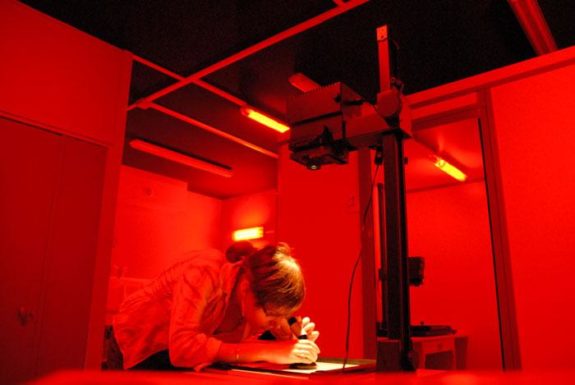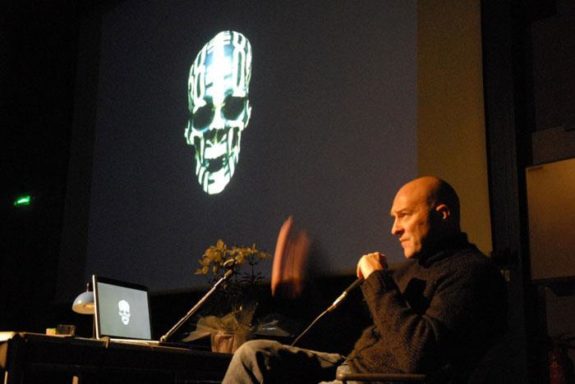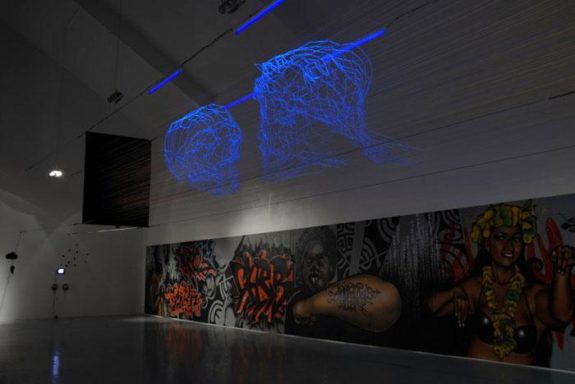The French Public Higher Schools of Art
Besançon
Institut supérieur des beaux-arts de Besançon/Franche-Comté
about
Three axes of development characterize the ISBA:
1. Research, being specific to our artistic and graphic practices, is not necessarily less underpinned by university laboratories, with whom we have created three PRS units – Structuring Research Departments, as long as they engage all of the pedagogy present in the school: print, the social contract, and the body of the artist.
2. International co-operation: more than an activity, the international represents a true dimension of development for the ISBA. To encourage this, a number of tools are available to us: Erasmus student exchanges and also exchanges with non European schools, foreign teachers and participants as part of the teaching staff, an international artist’s residency, study trips and an intensive teaching of english.
3. The cultural fabric which allows students to be placed into a professional situation of artist and author by producing and showing their work. In a similar fashion, various participants are invited and exhibitions organized each year. Among the most recent: Jean Dupuy, Thomas Hirschhorn, Perr Hutner, Phil Niblock, Kendel Geers, Peter Knapp, Harmen Liemburg.
Finally, two other dimensions also characterize our establishment:
– A constant practice of evaluation
– The monitoring of entry into professional life




Conférence de Kendell Geers (c) Isba Besançon
Conférence de Kendell Geers (c) Isba Besançon
Conférence de Kendell Geers (c) Isba Besançon
Conférence de Kendell Geers (c) Isba Besançon
options
Art
Communication
qualifications
DNA option Communication
DNSEP option Art
DNSEP option Communication
accreditation of prior learning and experience
DNAP option Art
DNAP option Communication
DNSEP option Art
DNSEP option Communication
Diplôme Universitaire sur la danse
research programmes
Social Contract
The Besançon/Franche-Comté Higher Institute of Fine Arts has chosen to concentrate its research on three main axes : The Body of the artist, Social Contract and Print. Each one of these axes has its initial grounding in the pedagogical initiatives of the artist teachers and theoreticians of the ISBA in close collaboration with a number of research laboratories within French and foreign universities, in addition to collaborations with other art schools and various institutions. This thinking is the subject of dialogues initiated and led during workshops for creation and research, conferences and other workshops in addition to seminars, study days, publications and exhibitions.
Social Contract
An intentional reference to Rousseau, the Social Contract research programme questions the engagement of the artist, and of the artist as citizen. It finds its roots in the economic, social and cultural history of the town of Besançon. The social utopia, fruit of the thinking of Charles Fourier and Pierre-Joseph Proudhon, both born in Besançon, is the well that this story has continued to draw from, with the memory of its working class being particularly impacted. From the strikes in the Rhodicéta factory in 1967 to the Lip affair in 1973 and the experiments in self-management of the company which followed, emancipation and self representation were some the true issues from which the Medvedkine was born. This history, with its international appeal encourages us today to question the place of the artist in society, his/her reception and his/her positions and attitudes faced with today’s world, his/her relationship with work and the new forms which can result from it.
The Social Contract section does its research in dialogue with different partners, the CIMEOS laboratory of the University of Bourgogne, that of Art&Flux of the University of Paris 1 – Panthéon-Sorbonne, the La Cambre Higher School of Visual Art in Brussels (Belgium), the National Institute of Fine Arts of Tétouan, the Tangiers Cinematheque (Morocco) and the Saline Royal among others.
Scientific managers:
Stéphanie Jamet-Chavigny (Doctor, Professor of history and art theory at the ISBA, collaborating member of the André Chastel Center, Paris-IV-Sorbonne University), Matthieu Laurette (Artist, Art/Multimedia teacher at the ISBA), Gilles Picouet (Artist, Volume teacher at the ISBA), Philippe Terrier-Hermann (Artist teacher at the ISBA and at the ENSAV of La Cambre).
Partnerships:
The La Cambre Higher School of Visual Arts in Brussels, the Art&Flux laboratory in the CERAP laboratory, University of Paris 1 – Panthéon-Sorbonne, the Franche-Comté Frac, the Tétouan National Institute for Fine Arts (Morocco), the La Cambre Higher School of Visual Art in Brussels (Belgium), the CIMEOS laboratory in semiology in the University of Bourgogne, Saline Royal of Arc-et-Senans.
The body of the Artist
The Besançon/Franche-Comté Higher Institute of Fine Arts has chosen to concentrate its research on three main axes : The Body of the artist, Social Contract and Print. Each one of these axes has its initial grounding in the pedagogical initiatives of the artist teachers and theoreticians of the ISBA in close collaboration with a number of research laboratories within French and foreign universities, in addition to collaborations with other art schools and various institutions. This thinking is the subject of dialogues initiated and led during workshops for creation and research, conferences and other workshops in addition to seminars, study days, publications and exhibitions.
The Body of the Artist
The Performance & Action Art field of experimentation has existed since 2009 and is made up of a research programme entitled Le Corps de l’artiste (The Body of the artist). This system is part of an international network of institutions – whose main partners are the Fine Arts faculty of the Valencia Polytechnic University, the faculty of Fine Arts of Athens – and is part of the working dynamic of a group of artists and researchers from a number of countries. The physical presence of the artist and his/her corporal engagement in the creation, is the subject of our questions, ones that focus on the essential issues in the fields of performance, action art, interaction with poetic zones and newer critical systems; performance art comes from the corporalized practices of the 1960s, inherited from the historical Avant gardes. Through the study of the implementation of exploratory and experimental propositions the idea is to build innovative research paths within the The Body of the Artist section, within a new epistemology that establishes contemporary research in the arts and the sciences.
Research team:
Michel Collet, head of the Art et Corps research entity, humanities/art teacher at the ISBA, Art Sciences laboratory of the University of Strasbourg EA3402. Démosthène Agrafiotis, Artist poet, honorary Professor at the University of Athens, Laurent Devèze, Director of the ISBA, philosopher, Aurore Desprès, lecturer and head of the university Art, Dance&Performance degree of the University of Franche-Comté, Jennifer K. Dick, lecturer UHA, Laboratory ILLE, Bartolomé Ferrando, Artist and poet, professor at the Polytechnic University of Valencia, Spain, André Éric Létourneau, Artist, Professor, University of Quebec in Montreal Institut ACTE (Arts/Creation/Theories/Esthetics),UMR 8218 CNRS, Jean-Luc Lupieri Philosopher, Eléni Mitropoulou, Professor of Sciences and Language, CeReS, University of Limoges, Nanta Novello Paglianti, lecturer in Language Sciences, CIMEOS, University of Bourgogne, Dijon. Valentine Verhaeghe, Artist performer, teaching at the ISBA, doctoral student in esthetics UFR Franche-Comté. Yann Toma, University Professor at Paris 1 Panthéon-Sorbonne, Director Art&Flux (Art, Economy & Society) research line, CERAP and of the Chair of Art & Economy at Paris 1 Panthéon-Sorbonne.
Partnerships:
The Corps de l’artiste center leads research in dialogue with different partners, the CIMEOS laboratory of the University of Bourgogne, Art&Flux of the Paris 1-Panthéon-Sorbonne University, researchers working on the Dance & Performance University Art Degree, at the Franche-Comté University, the Espace Gantner multimedia art center, Bourogne, the Kunsthalle Center for Art in Mulhouse, Athens School of Fine Arts, the faculty of Fine Arts, at the Politecnica University of Valencia.
publications
Exhibition catalogues, coproduction of works dedicated to young artists.
Publications connected to research
activities and events
Exhibitions, lectures, themed encounters, seminars, conferences.
post-curricular or extracurricular activities
Classes for non-degree students, adult learning evening classes and Wednesday classes for adolescents.
international cooperation
Numerous partnerships: Fachhochschule, Fachbereich Design of Dusseldorf (Germany) ; Universität Mozarteum Salzburg (Austria) ; The School of Graphic Research – ERG (Belgium), the Academy of Fine Arts of la Cambre, Brussels (Belgium) ; Faculty of Fine Arts of Barcelona, Académie de Cuenca, Académie de Valencia, Pablo Picasso School of Art of la Corogne, Number 10 School of Art of Madrid, Escuela de Arte de Oviedo (Spain) ; University of Huddersfield (Great Britain) ; the Athens School of Art (Greece) ; the Academy of Fine Arts of Florence, the Academy of Fine Arts of Frosinone, the Academy of Fine Arts of Naples (Italy) ; Royal academy of art La Haye (Holland) ; the Academy of Fine Arts of Cracovie, the Academy of Fine Arts of Warsaw (Poland) ; Insituto Politecnico de Tomar (Portugal) ; Université Purkineo of Usti Nad Labem (Czech Republic) ; Institut Communication Visuelle Bâle (Switzerland) ; the Academy of Fine Arts of Isik Istanbul, Karadeniz Teknik Universitesi Trabzon, TR Mimar Sinan Istanbul (Turkey).
gallery
Espace 24, the School gallery
specific equipment
Workshops in drawing, painting, video, sound, computer graphics, multimedia, internet, photography, screen printing, lead typography, wood, ceramic, metal, engraving.
Auditorium/ conference room
networks
ANdEA, Art Accord France.
Université de Franche-Comté (licence universitaire des métiers de l’exposition) ; le FRAC Franche-Comté et le 19-Centre d’art contemporain de Montbéliard, Université Paris 1 La Sorbonne, IUFM Vesoul, Musée des beaux-arts de Besançon, Espace Gantner, Lycée Jules Haag Besancon, CNEAI Chatou, Les Salines royales Arc-et-Senans.
administrative team
Laurent Devèze Directeur
Nathalie Gentilhomme Directrice adjointe
Brigitte Chorvot Responsable des études | relations internationales
Séverine Vuillemin Bibliothèque
Christelle Botton Secrétariat pédagogique
professors
Nicolas Bardey
Jean-Luc Bari
Didier Barthod-Malat
Pierre-Noël Bernard
Thomas Bizzarri
Christian Caburet
Rosalind Charnaux
Michel Collet
Gérard Collin-Thiébaut
Christophe Gaudard
Stéphanie Jamet-Chavigny
Anaïs Maillot
Isabelle Massu
Didier Mutel
Rainer Oldendorf
Géraldine Pastor-Lloret
Gilles Picouet
Martha SALIMBENI
Hugo Schuwer-Boss
Jocelyne Takahashi
Philippe Terrier-Hermann
Christophe Vaubourg
Gabriel Vieille
contact
12 rue Denis Papin
25000 | Besançon
tél. +33 (0)3 81 87 81 30
fax +33 (0)3 81 88 60 94
christelle.botton@besancon.fr
www.isba-besancon.fr
students
194 students